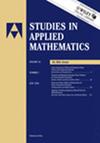致密磁等离子体(3+1)维量子欧拉-泊松系统的长波极限
IF 2.3
2区 数学
Q1 MATHEMATICS, APPLIED
引用次数: 0
摘要
本文给出了离子声波的(3+1)维量子Zakharov-Kuznetsov (QZK)方程的推导。在(3+1)维量子Euler-Poisson系统的长波限内,利用奇异摄动方法证明了通过Gardner-Morikawa变换可以系统地推导出QZK方程。导出的方程在O(ε−3/2)$ O(\varepsilon ^{-3/2})$阶的时间区间内有效。本文章由计算机程序翻译,如有差异,请以英文原文为准。
Long-Wavelength Limit of a Quantum Euler–Poisson System in the (3+1) Dimensions for a Dense Magnetoplasma
This paper presents the derivation of a (3+1)-dimensional quantum Zakharov–Kuznetsov (QZK) equation for ion acoustic waves. Using a singular perturbation method within the long-wavelength limit of the (3+1)-dimensional quantum Euler–Poisson system, we demonstrate that the QZK equation can be systematically derived through the Gardner–Morikawa transformation. The derived equation is valid over a time interval of order .
求助全文
通过发布文献求助,成功后即可免费获取论文全文。
去求助
来源期刊

Studies in Applied Mathematics
数学-应用数学
CiteScore
4.30
自引率
3.70%
发文量
66
审稿时长
>12 weeks
期刊介绍:
Studies in Applied Mathematics explores the interplay between mathematics and the applied disciplines. It publishes papers that advance the understanding of physical processes, or develop new mathematical techniques applicable to physical and real-world problems. Its main themes include (but are not limited to) nonlinear phenomena, mathematical modeling, integrable systems, asymptotic analysis, inverse problems, numerical analysis, dynamical systems, scientific computing and applications to areas such as fluid mechanics, mathematical biology, and optics.
 求助内容:
求助内容: 应助结果提醒方式:
应助结果提醒方式:


